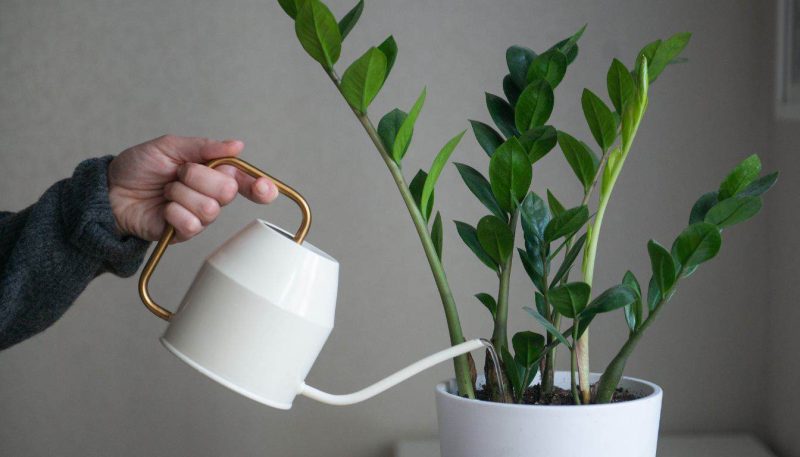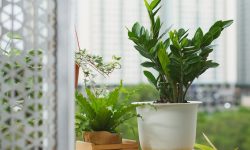ZZ plants are well known for their elegant look and impressive durability. Many people consider them the perfect choice for busy plant lovers who want greenery without complicated care. Still the watering routine for a ZZ plant often creates confusion. Many assume the plant barely needs moisture, yet it follows very specific watering needs. When you understand these needs you help the plant grow faster and stay stronger. New leaves appear more often and the roots develop in a steady pattern. The key is adjusting your watering habits based on the conditions in your home.
The watering rules are not difficult but they require careful observation. You cannot follow one fixed schedule for every space. Each home has different humidity levels, light exposure and temperature. These factors affect how fast the soil loses moisture. When you evaluate these elements the plant responds well. You maintain a moist balance without pushing the roots into soggy soil. This creates a stable routine that supports quick growth. A consistent approach helps the plant build energy for its next growth cycle. This becomes the foundation for long term health and steady development.
Understanding the Watering Needs of the ZZ Plant

The ZZ plant grows from thick rhizomes that act as natural water tanks. These structures store moisture for long periods and protect the plant during dry spells. Because of this feature the plant prefers a cycle of deep watering followed by a long dry phase. The soil must dry almost completely before you water again. This pattern mirrors the plant’s native environment where rainfall is rare but strong. When you follow this rhythm the plant grows faster and produces firm glossy leaves. The goal is to let the rhizomes rely on stored moisture instead of constant wet soil.
The watering schedule changes with your indoor conditions. Warm rooms cause water to evaporate faster. Cooler rooms hold moisture longer. Bright light speeds up growth and increases water use. Low light slows growth and reduces moisture demand. Your plant will signal when the cycle is right. The leaves stay firm and hold their deep green color. The stems stay upright and feel stable when touched. If the soil stays wet for too long the plant reacts with yellowing leaves. If the soil stays dry for too long the leaf tips may curl or wrinkle.
Proper watering begins with checking the soil. You should test the top layer with your finger. Dry soil to the depth of one or two inches means the plant is ready for water. Wet soil means you must wait longer. Slow pouring helps water reach the rhizomes. Fast pouring pushes water out too quickly. After watering you should allow excess water to leave the pot. This protects the roots from rot and keeps the soil airy. When the cycle is balanced the plant builds new shoots at a steady pace. This routine supports strong growth and long term health.
How Light and Temperature Affect the Watering Frequency
Light intensity plays a major role in how often you need to water a ZZ plant. Bright indirect light increases the plant’s metabolic rate and makes it use water more quickly. In these conditions the soil dries faster and the plant produces new growth at a steady pace. If your plant sits in a dim corner the soil stays wet for longer periods because the plant uses less moisture. Growth slows and the risk of overwatering becomes higher. When you assess the light correctly you will understand the drying pattern of the soil. This helps you avoid watering too early or too late.
Temperature also shapes your watering choices. Warm rooms create faster evaporation and promote quicker root activity. When the temperature rises the plant takes moisture from the soil more often. Cold rooms slow everything down and keep the soil wet for much longer. Sudden temperature drops cause stress and reduce water uptake. Consistency is important because stable temperatures help the plant maintain a predictable routine. You can watch the leaves to understand how the plant responds to its environment. Healthy leaves remain glossy and firm under stable conditions.
Light and temperature work together to define your schedule. When both are high the plant enters an active growth phase and needs more frequent watering. When both are low the plant slows down and needs longer dry periods. You must observe the soil and compare it with the plant’s appearance. These clues guide you toward the right moment to water. A balanced cycle prevents root rot and supports steady development. This approach helps the plant adapt easily to your home’s conditions. When these factors stay stable the plant grows with reliable strength and energy.
Signs Your ZZ Plant Needs Water
A ZZ plant gives clear signals when it is ready for its next drink. The first sign appears in the leaves. They start to lose their glossy finish and feel slightly softer when pressed. The green tone becomes a little dull because the plant uses stored moisture from its rhizomes. This natural shift helps you judge the right moment to water without relying on a fixed schedule. When the leaves feel thinner or begin to curl at the edges the plant is telling you it is entering a deeper stage of dryness. These changes show the rhizomes are running low on water reserves.
The stems also provide useful clues. Healthy stems stay upright and firm. When the plant becomes too dry the stems lean slightly or appear weaker than usual. This shift is not dramatic but becomes clear when you observe the plant over time. A slight bend means the plant is conserving energy. This state occurs when the soil has been dry for many days. If you continue to wait the stems may soften more. The plant can survive long dry periods but slow decline begins when moisture runs too low. Early detection helps maintain fast and steady growth.
The soil is the most reliable indicator. When the top inch feels dry the plant enters its safe watering zone. Deeper dryness suggests the rhizomes are ready for a full drink. When the soil feels cool or dense you should wait longer. Wet soil indicates the plant still holds enough moisture for many days. Consistent soil checks build a natural rhythm. This rhythm teaches you how your plant behaves in your home’s conditions. Once you read these signs correctly the watering cycle becomes simple, predictable and highly effective. This supports healthy roots and encourages regular new shoots.
How to Water a ZZ Plant Correctly for Faster Growth
Watering a ZZ plant correctly begins with giving the soil a deep and steady soak. The goal is to saturate the soil until moisture reaches the rhizomes hidden below the surface. Slow pouring allows the water to move evenly through the pot. Fast pouring forces water out before the plant absorbs it. You should stop when excess water begins to drain from the bottom. This shows the soil has reached full capacity. Deep watering activates the rhizomes and supports faster leaf production. When the plant receives moisture at the right depth it grows with stronger stems and healthier foliage.
After watering you must let all excess water escape. Standing water inside the pot suffocates the roots and creates an ideal environment for rot. A proper watering session includes a short waiting period until the pot finishes draining. Once complete you should empty any tray beneath the pot. This prevents the soil from reabsorbing stagnant water. A well-drained pot allows air pockets to form in the soil. These pockets keep the roots oxygenated and encourage new root growth. Oxygen is essential for the plant’s energy cycle. When the roots stay healthy the plant responds with quick and consistent growth.
The drying phase is just as important as the watering phase. ZZ plants depend on a complete dry cycle between waterings. This protects the rhizomes and builds resilience. You should check the soil every few days and observe how long it takes to dry in your environment. Warm and bright rooms speed the process. Cool and dim rooms slow it down. When the top inch feels dry you prepare for the next watering. When the pot feels noticeably light the soil has reached ideal dryness. This timing keeps the plant in a healthy rhythm. A steady rhythm promotes active growth and long lasting vigor.
Common Watering Mistakes That Slow ZZ Plant Growth
Overwatering and Its Hidden Impact on ZZ Plant Health
Overwatering is the most common mistake that slows the natural rhythm of a ZZ plant. The plant stores water in thick rhizomes, so it cannot use moisture as quickly as other houseplants. When the soil stays wet for too long, the rhizomes lose access to oxygen and begin to deteriorate. This lack of air circulation causes leaves to turn yellow and stems to soften. Many people believe yellow leaves mean the plant is thirsty, but the problem is often excess moisture lodged deep in the pot. Over time, this weakens the root system and delays new shoots from forming.
Another hidden effect of overwatering is the disruption of nutrient absorption. When the soil remains soggy, essential nutrients dissolve too rapidly and drift away from the rhizomes. The plant then receives water but not enough nutrition to support growth. This leads to pale foliage, slow development, and a higher chance of root decay. When the plant repeatedly sits in wet soil, harmful fungi thrive, creating conditions for rot. A healthy ZZ plant always prefers a dry interval because dryness keeps the rhizomes firm and strong. Adjusting your watering schedule prevents these issues and restores the plant’s natural pace.
Shallow Watering and Its Effect on Root Development
Shallow watering happens when growers add only a small amount of water during each session. Many do this because they fear soaking the soil too deeply. However, shallow watering only wets the surface while the bottom layer stays dry. The rhizomes depend on full saturation to gather moisture for long periods. When they do not receive enough water, they enter a survival mode that slows growth. Stems become thinner and new leaves stop forming. The plant then relies entirely on its limited water reserves, which weakens its long-term growth potential.
Inconsistent moisture from shallow watering also confuses the plant’s internal rhythm. The ZZ plant thrives when each watering event is deep and predictable. When water never reaches the lower root zone, the rhizomes cannot focus on building new roots. Instead, they try to conserve energy to withstand dryness that appears unplanned. Over time, this creates stress in the plant. Deep watering prevents this cycle by pushing moisture into all layers of the soil. With every watering reaching the bottom of the pot, the plant returns to a stable routine. This stability results in faster growth and a stronger structure.
Poor Soil Choices and How They Affect Watering Success
Using dense or heavy soil is another mistake that affects how water moves through the pot. ZZ plants need loose and airy soil that drains quickly. When the soil is too compact, it holds moisture longer than the plant can tolerate. This leads to waterlogged conditions that suffocate the rhizomes and slow their ability to send nutrients upward. The plant reacts with dull leaves and slow growth. Heavy soil also dries unevenly, keeping the lower layer wet even when the surface appears dry. This creates a false sense of dryness and increases the risk of accidental overwatering.
Well-draining soil creates a balanced moisture cycle that matches the natural behavior of the ZZ plant. Air pockets help oxygen reach the roots and support strong growth. When water passes easily through the soil, it prevents harmful fungi from developing. A clean dry-to-wet rhythm forms, giving the rhizomes enough time to process stored moisture before receiving more. This steady cycle encourages the plant to produce new shoots more often. By choosing the right soil mixture, you create a safe environment for the plant to thrive. It becomes easier to read the soil, adjust your watering schedule, and maintain consistent growth.
How Pot Size and Pot Material Affect Your Watering Routine
The size of the pot plays a major role in how often your ZZ plant needs water. A large pot holds more soil, and more soil means more moisture is retained for a longer time. This slows the drying cycle and increases the risk of overwatering if you follow a fixed schedule. A small pot dries much faster and pushes the plant into quicker watering intervals. When the roots have limited space they absorb water more rapidly. The right pot size maintains a stable rhythm that matches your home’s conditions. A balanced rhythm supports strong root activity and encourages steady growth.
Pot material also changes the speed at which the soil loses moisture. Terracotta pots absorb water through their porous surface. This allows moisture to escape more quickly and helps prevent waterlogged conditions. Plastic pots hold moisture for much longer because they do not breathe. This increases the chance of soggy soil if you water too frequently. Ceramic pots fall somewhere in the middle depending on their glaze. When you understand how each material behaves you can create a watering schedule that matches the drying speed. This awareness prevents mistakes and keeps the soil airy.
Drainage holes are another key factor in watering success. Pots without holes trap excess water at the bottom and create hidden pockets of moisture. These pockets cause slow root damage that may not appear until it is advanced. A well-draining pot allows water to leave the soil quickly and keeps the rhizomes safe. It creates a clean cycle of wet and dry that the plant depends on for healthy growth. When pot size, material and drainage work together the plant forms a predictable routine. This routine helps the ZZ plant grow with strength, stability and consistent energy.
Seasonal Changes and How They Affect Your Watering Schedule
Seasonal shifts have a strong influence on how your ZZ plant uses water. During warm months the plant enters a more active growth phase. Higher temperatures increase evaporation and push the soil to dry more quickly. The plant uses more moisture to support new stems and fresh leaves. This active period creates a shorter watering interval. You will notice the pot feels lighter after only a few days because the roots work harder. When you match your schedule to this faster cycle the plant responds with strong and regular growth. A well-timed routine supports the natural rhythm of the season.
As temperatures drop the plant slows its internal processes. Cooler air holds moisture for longer and reduces the plant’s water consumption. This slower pattern extends the drying period between each watering. If you continue watering at a summer pace the soil stays wet for too long. The rhizomes suffer from low oxygen and the leaves begin to fade. Winter is the time when most overwatering accidents occur. You must rely on soil checks rather than habit. A consistent finger test prevents mistakes and keeps the plant stable throughout the colder months.
Humidity also changes with the seasons. Warm weather usually increases humidity and slows evaporation in some homes. Dry indoor heating in winter pulls moisture from the soil more slowly but dries the air around the plant. These opposites can make the watering rhythm confusing. Watching the soil gives you the clearest direction. When the top inch stays dry for several days the plant is ready for water. When it stays moist you should wait longer. Seasonal understanding helps you create a flexible routine. A flexible routine ensures the ZZ plant grows with strength through every part of the year.
How Humidity Influences ZZ Plant Watering Needs
Humidity affects how quickly moisture leaves the soil and how efficiently the ZZ plant uses water. In high humidity the air holds more moisture and slows evaporation from the pot. The soil stays damp for a longer time and the plant uses water at a slower pace. This extended moisture period reduces the need for frequent watering. When humidity remains high the plant focuses on maintaining its leaves rather than pushing new growth. You must observe the soil closely during these periods because the plant may go many days without needing additional moisture. A careful routine prevents the soil from staying wet too long.
Low humidity creates the opposite effect. Dry air pulls moisture from the soil faster and forces the plant to rely on its stored reserves more quickly. The rhizomes respond by sending water upward to support the leaves. This makes the soil dry sooner and shortens the interval between watering sessions. Leaf tips may wrinkle slightly when humidity drops too low. This is a normal response but should guide your attention to the soil. When the pot dries at a rapid pace you must be prepared to water when the top inch feels dry. Consistent checks help the plant stay hydrated without becoming stressed.
Humidity also changes how the plant breathes through its leaves. In moist air the stomata remain more relaxed and lose less water. In dry air they work harder to conserve moisture. This natural behavior affects the plant’s overall rhythm and should guide your watering choices. You do not need to mist a ZZ plant because the leaves store enough moisture. Instead you should let the soil dictate the next watering. When humidity stays balanced the plant maintains a steady cycle of growth. A stable cycle encourages new shoots and supports long term strength in every season.
How Soil Type Determines the Perfect Watering Rhythm
Soil type controls how long moisture stays around the rhizomes and how quickly the pot dries between watering sessions. A loose and airy mix creates the ideal environment for a ZZ plant. This type of soil allows water to move freely through the pot and reach the bottom roots without becoming stagnant. When water drains well the soil resets to a dry state at a predictable pace. This predictable pace helps you create a steady watering rhythm that matches your plant’s natural cycle. A light mix also keeps the rhizomes oxygenated. Oxygen supports root activity and encourages strong new shoots throughout the year.
Dense or compact soil behaves in a completely different way. Heavy soil holds water for longer periods and slows the drying process. This often misleads growers because the top may appear dry while the lower layer still holds moisture. Wet pockets remain hidden around the rhizomes and create conditions for early rot. When soil restricts airflow the roots cannot breathe and slowly weaken. The plant begins to show dull leaves and unsteady growth. If the plant receives shallow watering on top of heavy soil it becomes even more stressed. This combination disrupts the moisture cycle and delays new growth for weeks.
Choosing the right soil determines how easily you can manage your watering schedule. A mix containing coarse elements like perlite or bark helps water escape quickly and creates natural air pockets. These pockets prevent compression and keep the soil structure open. When the soil dries evenly the plant builds a dependable rhythm. You can water deeply without fear of trapping moisture. Each drying period becomes clear and easy to observe. Over time the plant responds with more consistent growth and stronger stems. Good soil allows every watering session to benefit the plant rather than stress it, making care effortless and reliable.
How to Check Soil Moisture Properly Before Watering
Checking soil moisture is the most reliable way to decide when your ZZ plant needs water. The plant does not follow a fixed schedule because every home has different light, temperature and airflow patterns. The simplest method is using your finger to test the top layer of soil. When the first inch feels completely dry the plant enters its safe watering zone. If the soil feels cool or slightly damp you must wait longer. This direct touch is more accurate than guessing by the calendar because it reflects the plant’s real environment. A consistent testing habit keeps the soil from staying wet for too long.
The weight of the pot also helps you measure moisture levels. Dry soil feels light because air fills the spaces between particles. Wet soil feels heavy because water sits inside the mix and increases its density. You can lift the pot slightly to compare these differences. After a few weeks you will recognize the plant’s pattern and know when the pot signals dryness. This skill becomes more useful as seasons change. It prevents overwatering during winter and ensures the plant gets enough moisture during warm months. Learning the pot’s weight simplifies the entire watering process.
Moisture meters are another helpful tool if you prefer a clear reading. These devices measure electrical resistance inside the soil to estimate moisture levels. A meter inserted into the lower layer reveals the true state of the rhizomes. This can prevent mistakes when the surface appears dry but the base is still wet. It also guides you when the soil type holds moisture unevenly. While a meter is not essential it gives reassurance for beginners. When combined with visual signs and touch tests the reading becomes more accurate. Each method works together to build a precise watering routine that keeps the plant growing quickly and healthily.
Common Mistakes to Avoid When Watering a ZZ Plant
Watering on a Fixed Schedule Instead of Checking the Soil
Watering a ZZ plant on a strict weekly routine prevents you from understanding its natural rhythm. The plant absorbs water based on your home’s light, airflow and heat, so it may dry quickly in summer but stay wet for many days in winter. When you continue watering according to a preset schedule, the soil remains moist even when the plant does not need it. This pushes the rhizomes into constant stress because they cannot breathe through layers of wet soil. In this state the plant loses its ability to transport nutrients upward, leading to weak stems and slow leaf expansion. Many growers misjudge these symptoms as underwatering and continue adding water, which gradually worsens the imbalance.
To prevent this cycle, you must rely on soil checks before each watering session. The top layer must feel fully dry, and the pot should feel noticeably lighter when lifted. This simple approach adapts to every environmental change, including seasonal humidity shifts and temperature drops. Soil checks also reveal whether your potting mix is drying evenly. By understanding these signals, you avoid accidental overwatering and allow the rhizomes to rest between cycles. A consistent dry period strengthens the root structure and establishes a reliable growth pattern. When you replace a strict schedule with observation, the plant grows faster, steadier and with richer foliage.
Poor Drainage and Using the Wrong Potting Conditions
Poor drainage creates one of the most dangerous watering conditions for ZZ plants because excess water settles around the rhizomes. Pots with small holes or no holes prevent water from leaving the container, creating a stagnant zone at the bottom. These wet areas stay moist long after the surface has dried, tricking growers into watering again. Dense soils such as peat-heavy mixes worsen this issue because they compress easily and restrict airflow. Over time the rhizomes begin to soften and rot, reducing the plant’s ability to produce new shoots. These issues often develop quietly until the plant shows advanced symptoms of decline.
Improving drainage begins with choosing a pot that allows water to escape freely. Large drainage holes ensure moisture moves quickly through the soil, keeping the lower layers breathable. A proper soil mix should include coarse materials like bark, perlite or pumice, which create open pathways for air and water. These components prevent compaction and maintain a stable environment around the rhizomes. When water drains effectively, the soil dries at a predictable pace and supports a healthy wet-to-dry cycle. This cycle encourages the plant to form stronger roots, resist fungal growth and produce consistent new leaves. Proper drainage safeguards the plant’s growth rhythm and makes watering much easier to manage.
Misreading the Plant’s Signals and Watering Incorrectly
Misreading a ZZ plant’s signals often leads to watering at the wrong moment. Many growers do not realize that similar symptoms can represent opposite problems. Drooping stems may indicate dryness but can also appear when roots sit in wet soil and begin to suffocate. Slight wrinkles on the leaves mean the rhizomes are using their stored moisture, while yellow patches often signal that the plant has been watered too frequently. Without checking the soil, these signals can be confusing. When growers react impulsively and water based on appearance alone, the plant enters a stress cycle that slows growth and disrupts its internal rhythm.
Correct watering decisions always begin with understanding the soil condition. Dry soil feels coarse and airy, while wet soil feels heavy, cool and compact. Lifting the pot helps reveal this difference even when visual cues are unclear. A moisture check ensures that the plant receives water only when the rhizomes are ready to absorb it. This method prevents both underwatering and accidental overwatering. Over time you learn to read subtle changes, such as how quickly the soil dries in bright light or how leaves behave during cool seasons. When these observations guide your decisions, the plant stays in a stable hydration cycle and grows with consistent strength and resilience.
FAQs About How Often to Water ZZ Plant
How often should I water a ZZ plant indoors?
A ZZ plant indoors usually needs watering only when the top inch of soil becomes completely dry. Indoor environments vary widely, so you should rely on soil checks rather than a fixed schedule. Some homes may require watering every two weeks, while others may need a longer drying period. The plant grows best when you allow the soil to reset fully between watering sessions.
Why do ZZ plant leaves turn yellow after watering?
Yellow leaves often indicate that the soil remained wet for too long. When the rhizomes sit in moisture without enough air, they cannot function properly and begin to soften. This disrupts nutrient flow and causes leaf discoloration. Checking moisture levels before watering prevents this issue and keeps the plant in a stable state.
Can a ZZ plant recover from overwatering?
A ZZ plant can recover if overwatering is corrected early. You must allow the soil to dry completely and remove any mushy roots or rhizomes. Improving drainage also helps the pot reset faster. Once the plant reaches a normal wet-to-dry cycle, new shoots eventually appear and the plant regains strength.
How do I know if my ZZ plant needs water?
Dry soil is the most reliable indicator. The top layer must feel crumbly and powdery rather than cool or dense. The pot often feels lighter than usual when the soil becomes fully dry. Visual signs like slightly wrinkled leaves can also help, but soil checks should always guide your decision.
Should I mist my ZZ plant to increase humidity?
Misting is unnecessary because ZZ plant leaves do not rely on surface moisture. The plant stores water in its rhizomes and maintains leaf hydration well even in low humidity. Rather than misting, focus on proper soil drying since excess moisture around the roots creates more risk than dry air does.






